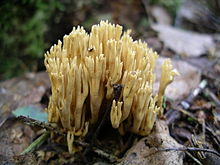Phaeoclavulina abietina
| Phaeoclavulina abietina | |
|---|---|

| |
| Scientific classification | |
| Domain: | Eukaryota |
| Kingdom: | Fungi |
| Division: | Basidiomycota |
| Class: | Agaricomycetes |
| Order: | Gomphales |
| Family: | Gomphaceae |
| Genus: | Phaeoclavulina |
| Species: | P. abietina
|
| Binomial name | |
| Phaeoclavulina abietina | |
| Synonyms[8] | |
Phaeoclavulina abietina, commonly known as the green-staining coral, is a coral mushroom in the family Gomphaceae. It is characterized by the green staining reaction it develops in response to bruising or injury.
Taxonomy[edit]
The species was first described by Christian Hendrik Persoon in 1794 as Clavaria abietina. It is commonly known as the "green-staining coral".[9] It was classified in the genus Ramaria (in the subgenus Echinoramaria),[7] until molecular phylogenetic showed that Ramaria was polyphyletic.[10]
Description[edit]
Fruit bodies are leathery, and brittle when dry. They are small, measuring 2–5 cm (3⁄4–2 in) tall by 1–3 cm (3⁄8–1+1⁄8 in) wide, and branch from the central stem up to five times. The slender branches are slightly flattened or spreading, and forked or crested near the top. The color of the fruit body is medium yellow green to light olive, but will bruise a darker olive green to dark olive green. The stem is short, and have a mat of mycelia at its base, which is attached to rhizomorphs that branch into the substrate. The odor of the mushroom tissue ranges from indistinct to earthy, and it tastes initially sweet, then somewhat bitter.[9] The species is inedible.[11]
The spores are dark orange-yellow when collected in mass. Spores are pip-shaped to broadly elliptical, with one oblique end; their dimensions are 6–9 by 3.5–4.5 μm.[7] The basidia (spore-bearing cells) are typically four-spored, with the spores attached by sterigmata up to 7 μm long.[9]
Similar species[edit]
Similar in appearance is Ramara invalii, but this species does not stain when bruised.[9]
Habitat and distribution[edit]
| Phaeoclavulina abietina | |
|---|---|
| Smooth hymenium | |
| Hymenium attachment is irregular or not applicable | |
| Stipe is bare | |
| Edibility is inedible | |
Fruit bodies grow scattered or in groups (sometimes arranged in rows)[7] on the ground in duff of coniferous forests. In North America, it is found in the Pacific Northwest[9] and Mexico.[12] It is also found in Europe.[13]
References[edit]
- ^ Giachini AJ, Castellano MA (2011). "A new taxonomic classification for species in Gomphus sensu lato". Mycotaxon. 115: 183–201. doi:10.5248/115.183.
- ^ Persoon CH (1794). "Neuer Versuch einer systematischen Eintheilung der Schwamme". Neues Magazin für die Botanik Römer (in Latin). 1: 63–80.
- ^ Sprengel C. (1827). Caroli Linnaei systema vegetabilium (in Latin). Vol. 4 (16th ed.). Göttingen, Germany: Sumtibus Librariae Dieterichianae. p. 495.
- ^ Duby JE (1830). Botanicon gallicum. Vol. 2 (2nd ed.). Paris, France: Desray. p. 778.
- ^ Schröter J. (1888). Kryptogamen-Flora von Schlesien (in German). Vol. 3–1. Lehre, Germany: Cramer. p. 448.
- ^ Quélet L. (1888). Flore mycologique de la France et des pays limitrophes (in French). Paris, France: Octave Doin. p. 467.
- ^ a b c d Trudell, Steve; Ammirati, Joe (2009). Mushrooms of the Pacific Northwest. Timber Press Field Guides. Portland, OR: Timber Press. p. 245. ISBN 978-0-88192-935-5.
- ^ "Ramaria abietina (Pers.) Quél. 1888". MycoBank. International Mycological Association. Retrieved 2012-10-21.
- ^ a b c d e Tylukti E.E. (1987). Mushrooms of Idaho and the Pacific Northwest. Vol. 2. Non-gilled Hymenomycetes. Moscow, Idaho: The University of Idaho Press. pp. 93–4. ISBN 0-89301-097-9.
- ^ Humpert AJ, Muench EL, Giachini AJ, Castellano MA, Spatafora JW (2001). "Molecular phylogenetics of Ramaria and related genera: evidence from nuclear large subunit and mitochondrial small subunit rDNA sequences". Mycologia. 93 (3): 465–77. doi:10.2307/3761733. JSTOR 3761733.
- ^ Miller Jr., Orson K.; Miller, Hope H. (2006). North American Mushrooms: A Field Guide to Edible and Inedible Fungi. Guilford, CN: FalconGuide. p. 348. ISBN 978-0-7627-3109-1.
- ^ Montoya A; Hernández-Totomoch; Estrada-Torres A; Kong A; Caballero J (2003). "Traditional Knowledge about Mushrooms in a Nahua Community in the State of Tlaxcala, México". Mycologia. 95 (5): 793–806. doi:10.2307/3762007. JSTOR 3762007. PMID 21148986.
- ^ Jordan M. (2004). The Encyclopedia of Fungi of Britain and Europe. London, UK: Frances Lincoln. p. 89. ISBN 0-7112-2378-5.
